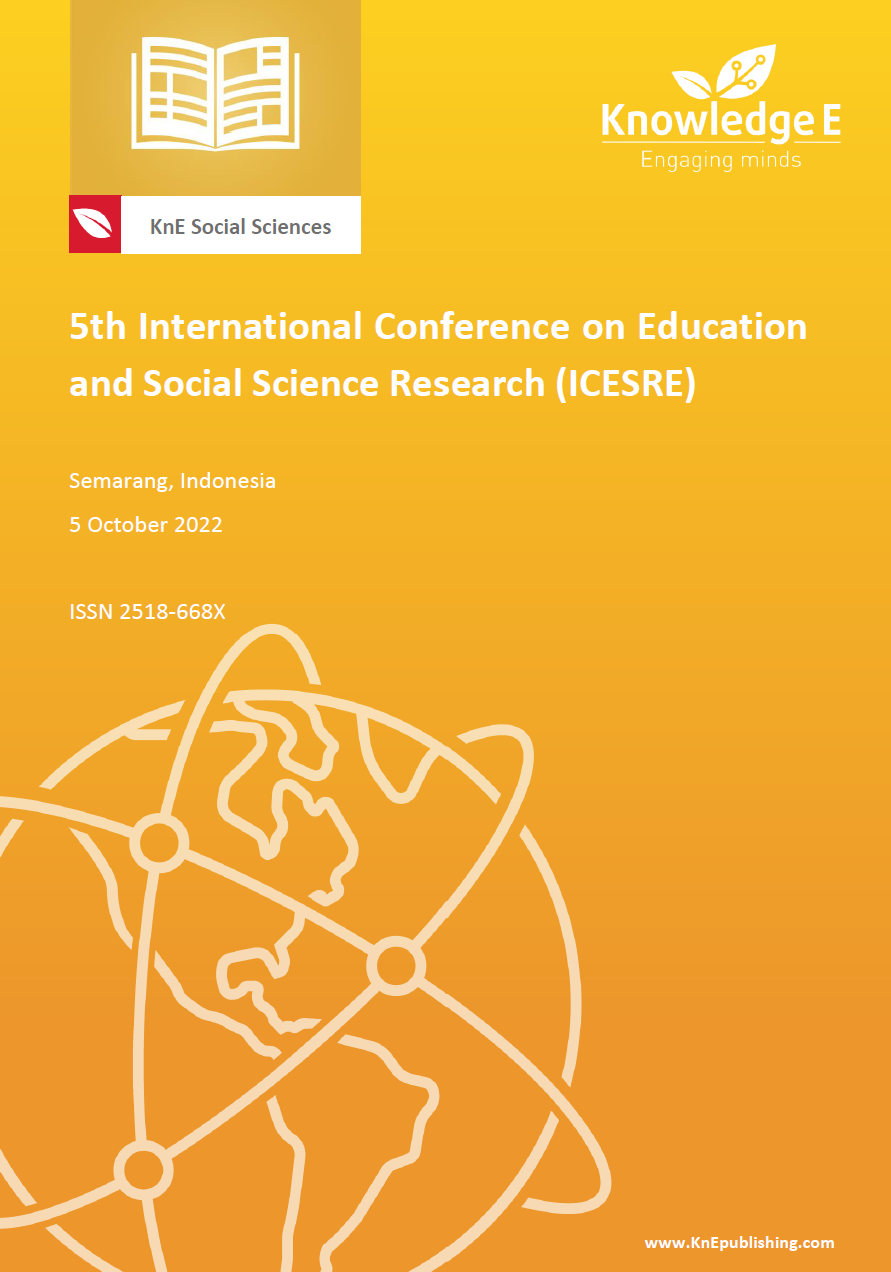When Fun Turns Into Hedonism: Boon or Calamity?
DOI:
https://doi.org/10.18502/kss.v7i19.12423Abstract
Adolescent behaviour is influenced by their surrounding environment and by them being an active agent in shaping their own environment. The ability to adjust to campus environments is associated with certain psychosocial factors, including parental support and peer attachment. The majority of adolescents with moderate and high levels of hedonistic behaviour were found among undergraduate students. It was discovered that millennials explore identity theory more by utilizing all the conveniences of fintech services to achieve their financial goals. The development of fintech in Indonesia continues to advance, one of which is a new breakthrough that has emerged and is widely discussed, named Spaylatter. The purpose of this study was to determine the moderating effect of peer attachment on the hedonistic behaviour of undergraduate students in Jombang. By using a post-positivist approach, the case study is a limited system. In this study, it was found that the pattern of life is influenced by opinion, interest, and activity. It is found that the Credit option is used when it is a situation of urgency, not having funds or facing a financial problem. It also found that hedonistic lifestyle behaviours include buying just for pleasure and being the centre of attention. Based on the results of research and observations, the following conclusions can be drawn: pattern of life is influenced by the opinion of someone who is affected by the program, credit options are used in times of urgency, from this credit option, it can lead to a hedonic lifestyle.
Keywords: Hedonism, Lifestyle, Fintech, Self-actualization, Online Credit, Pay Later
References
[2] Benavides-Espinosa MM, Mohedano-Suanes A. Women’s entrepreneurship and economics. Germany: Springer; 2012. Linking women entrepreneurship with social entrepreneurship; p. 53–71.
[3] Bronfenbrenner U. Ecological system theory. Annals of Child Development. 1989;6:187–249.
[4] Hamzah SR, Krauss SE, Suandi T, Hamzah A, Tamam E. The moderating effect of parent and peer influences on hedonistic behavior among undergraduate students in Malaysia. Asian Social Science. 2013;9:137.
[5] Zimbardo PG, Boyd JN. Time perspective theory; review, research and application. Germany: Springer; 2015. Putting time in perspective: A valid, reliable individualdifferences metric. p. 17–55.
[6] Martínez-Alemán AM. Social media go to college. Change: The Magazine of Higher Learning. 2014;46:13–20.
[7] Reetz E, Quackenbush W. Creating collaborative learning opportunities for indigenous youth with archaeology-based environmental education. Advances in Archaeological Practice. 2016;4:492–502.
[8] Kurniasari I, Fisabilillah LWP. Fenomena perilaku berbelanja menggunakan spaylater serta dampaknya terhadap gaya hidup mahasiswa ilmu ekonomi. The Independent Review. 2021;1:207–218.
[9] Perrin A. Social media usage. Pew Research Center. 2015;125:52–68.
[10] Mathews AJ, Lu Y, Patton MT, Dede-Bamfo N, Chen J. College students’ consumption, contribution, and risk awareness related to online mapping services and social media outlets: does geography and GIS knowledge matter? GeoJournal. 2013;78:627–39.
[11] Taylor ZE, Eisenberg N, Spinrad TL, Eggum ND, Sulik MJ. The relations of egoresiliency and emotion socialization to the development of empathy and prosocial behavior across early childhood. Emotion. 2013;13:822.
[12] Bronfenbrenner U. The ecology of cognitive development: Research models and fugitive findings. Development in Context Acting and Thinking in Specific Environments. 1993;3:46.
[13] Veenhoven R. Hedonism and happiness. Journal of Happiness Studies. 2003;4:437– 457.
[14] Kanov J. Why suffering matters! Journal of Management Inquiry. 2021;30:85–90.
[15] Denzin NK, Lincoln YS, Giardina MD. Disciplining qualitative research. International Journal of Qualitative Studies in Education. 2006;19:769–782.
[16] Rofiah C, Bungin B. Qualitative methods: Simple research with triangulation theory design. Develop. 2021;5:18–28.
[17] Ngafifi M. Kemajuan teknologi dan pola hidup manusia dalam perspektif sosial budaya. J Pembang Pendidik Fondasi dan Apl. 2014;2(1).
[18] Ismail K. The structural manifestation of the ‘Dutch disease’: The case of oil exporting countries. New Hampshire, USA: International Monetary Fund; 2010.
[19] Valter V, Oliveira SF, Falcao AC. A meta-analytic review of hedonic and utilitarian shopping values. Journal of Consumer Marketing. 2018;35:426–437.
[20] Armsden GC, Greenberg MT. The inventory of parent and peer attachment: Individual differences and their relationship to psychological well-being in adolescence. Journal of Youth and Adolescence. 1987;16:427–454.
[21] Ru X, Wang S, Yan S. Exploring the effects of normative factors and perceived behavioral control on individual’s energy-saving intention: An empirical study in eastern China. Resources, Conservation and Recycling. 2018;134:91–99.
[22] Jas Laile Suzana J. Introduction to children and adolescents psychology. Shah Alam Arah Pendidik Sdn Bhd. 2008.
[23] Durlak JA, Weissberg RP, Pachan M. A meta-analysis of after-school programs that seek to promote personal and social skills in children and adolescents. American Journal of Community Psychology. 2010;45:294–309.
[24] Kandel DB. Similarity in real-life adolescent friendship pairs. Journal of Personality and Social Psychology. 1978;36:306.
[25] Kimbu AN, Ngoasong MZ. Women as vectors of social entrepreneurship. Annals of Tourism Research. 2016;60:63–79.
[26] Tomé G, de Matos MG, Simões C, Camacho I, AlvesDiniz J. How can peer group influence the behavior of adolescents: Explanatory model. Global Journal of Health Science. 2012;4:26.
[27] Glaser B, Shelton KH, van den Bree MBM. The moderating role of close friends in the relationship between conduct problems and adolescent substance use. Journal of Adolescent Health. 2010;47:35–42.
[28] Walden LM, Beran TN. Attachment quality and bullying behavior in school-aged youth. Canadian Journal of School Psychology. 2010;25:5–18.

